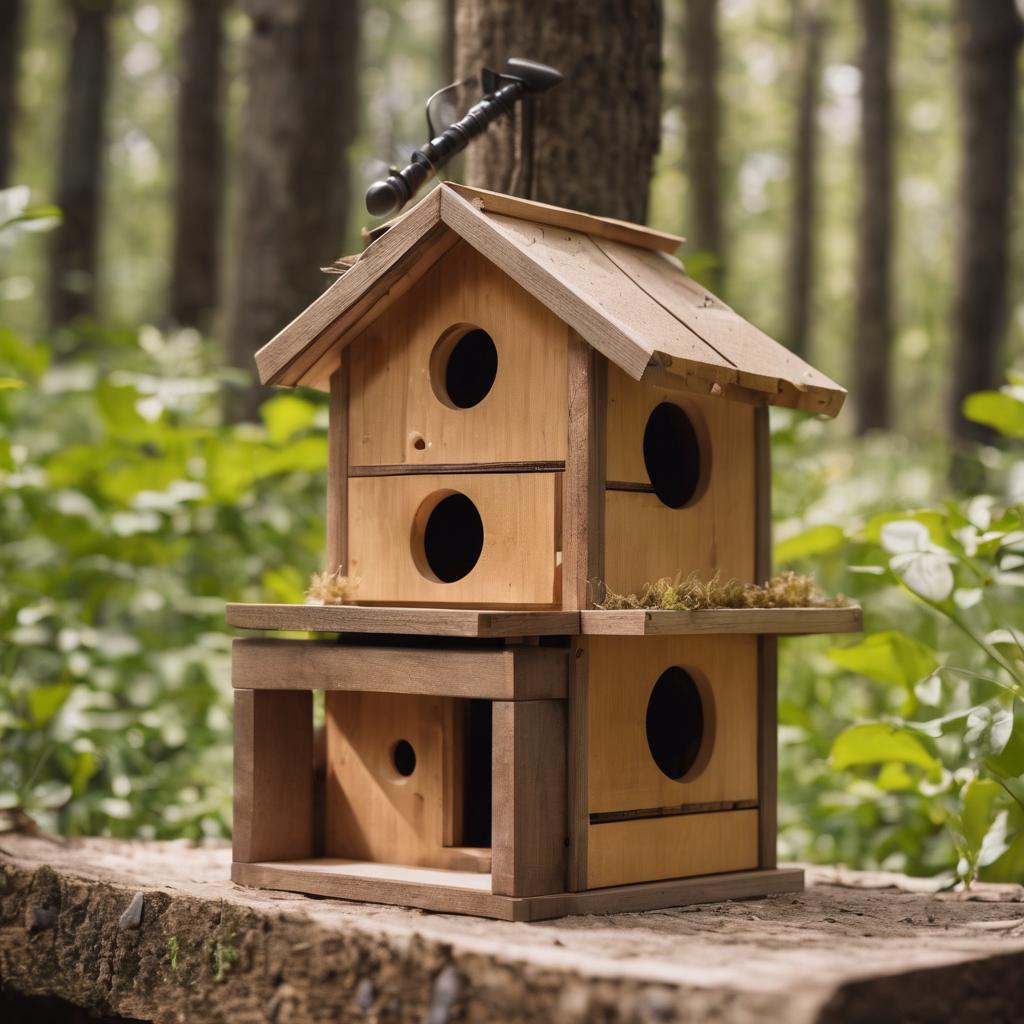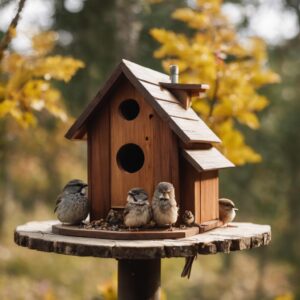
How to Build a Birdhouse for Different Species
Contents
- 1 Understanding the Needs of Different Bird Species
- 2 Selecting the Right Materials for Your Birdhouse
- 3 Choosing the Ideal Birdhouse Design for Each Species
- 4 Providing the Correct Dimensions for Nesting Boxes
- 5 Creating Appropriate Entry Holes for Different Birds
- 6 Adding Ventilation and Drainage to Ensure Birdhouse Longevity
- 7 Placing Birdhouses in the Right Location for Each Species
- 8 Maintaining and Cleaning Birdhouses to Attract Birds
- 9 Monitoring and Observing Bird Behavior in Your Birdhouses
- 10 Troubleshooting Common Issues with Birdhouses for Different Species
Understanding the Needs of Different Bird Species
Birds, like any other living organisms, have specific needs that must be met in order for them to thrive in their environment. Understanding these needs is crucial when it comes to attracting and encouraging birds to nest in your birdhouses. Each bird species has its own unique set of requirements, ranging from the type of materials used to construct their nests to the dimensions and design of the birdhouses themselves.
It is important to consider the natural habits and preferences of different bird species when setting up your birdhouses. Some species prefer open-fronted designs, while others require a specific entry hole size or shape. Additionally, the location of the birdhouse plays a significant role in attracting particular bird species. By understanding the specific needs of different birds, you can create a welcoming environment that meets their requirements and increases the chances of successful nesting.
Overall, understanding the needs of different bird species is essential for successfully attracting and accommodating a wide variety of birds in your outdoor space. By selecting the right materials, dimensions, and design for your birdhouses, as well as placing them in the appropriate location, you can create a welcoming haven for birds to flourish. Moreover, regularly maintaining and cleaning the birdhouses will ensure their longevity, while monitoring and observing bird behavior can provide valuable insights into their needs and any issues that may arise.
Selecting the Right Materials for Your Birdhouse
To create a safe and comfortable home for birds, selecting the right materials for your birdhouse is essential. The material you choose will not only determine the durability of the house but also play a crucial role in attracting specific bird species. When it comes to birdhouse materials, natural and untreated options are generally recommended. Wood is a popular choice as it provides insulation and a natural aesthetic that blends well with any environment. Cedar and pine are excellent options as they are resistant to decay and rot, ensuring the longevity of the birdhouse. Additionally, it is important to avoid using pressure-treated wood or paints that contain harmful chemicals, as these can be toxic for the birds.
Another material worth considering is recycled plastic, which is both weather-resistant and long-lasting. Birdhouses made from recycled plastic are durable and easy to maintain, making them a sustainable option. Additionally, plastic can offer excellent insulation and protection against harsh weather conditions. Ensure that the plastic used is thick enough to withstand external forces and that the birdhouse has proper ventilation to avoid condensation inside. When choosing birdhouse materials, keep in mind the specific needs and behaviors of the bird species you are targeting. This will help create an inviting space that encourages birds to make your birdhouse their home.
Choosing the Ideal Birdhouse Design for Each Species
There is no one-size-fits-all approach when it comes to designing birdhouses for different species. Each bird has its own specific requirements and preferences, so understanding their needs is crucial to creating an ideal design. The size and shape of the birdhouse, as well as the entry hole diameter, should be tailored to accommodate the specific species you are targeting.
For example, cavity-nesting birds such as bluebirds and chickadees prefer a slightly rectangular shape with a hole diameter ranging from 1-1/2 to 1-9/16 inches. On the other hand, larger birds like woodpeckers and owls require much larger cavities and entry holes, usually measuring around 4 inches in diameter. By considering the unique characteristics and habits of each species, you can ensure that your birdhouse design is a perfect fit and attracts the birds you want to observe in your backyard.
Providing the Correct Dimensions for Nesting Boxes
Nesting boxes play a crucial role in providing a safe and suitable habitat for birds to reproduce and raise their young. When it comes to constructing or purchasing nesting boxes, it is essential to ensure that the dimensions are appropriate for the specific species that you want to attract. Each bird species has different requirements and preferences when it comes to the size of their nesting boxes.
First and foremost, the size of the nesting box should be proportional to the size of the bird. Smaller birds, such as wrens or chickadees, will typically require smaller nesting boxes, whereas larger birds, like bluebirds or owls, will need larger boxes. Providing the right dimensions ensures that the bird can comfortably enter and exit the box, as well as move around inside it. Additionally, the size of the entrance hole should be carefully considered, as it should be large enough to accommodate the bird but also small enough to deter predators. By understanding the specific dimensions required by each bird species, you can increase the likelihood of birds nesting in the boxes you provide, contributing to their overall conservation and well-being.
Creating Appropriate Entry Holes for Different Birds
Entry holes in birdhouses play a crucial role in attracting specific bird species. Each bird has its own unique requirements when it comes to the size and shape of the entrance hole. When creating entry holes for different birds, it is important to consider the size of the bird, as well as any specific predation risks or competition for the nesting site.
For larger bird species such as woodpeckers or owls, entry holes should be larger, typically around 2-3 inches in diameter. These birds require ample space to enter and exit the birdhouse comfortably. On the other hand, smaller bird species like bluebirds or chickadees prefer smaller entry holes, usually around 1-1.5 inches in diameter. The smaller size helps to deter larger and more aggressive birds from taking over the nesting site.
In addition to size, the shape of the entry hole is also important. Some birds, like tree swallows, prefer a more oval-shaped hole, while others, such as wrens, prefer a round hole. The shape of the entry hole can also help deter unwanted visitors or predators from gaining access to the birdhouse.
Creating appropriate entry holes for different bird species not only ensures the safety and comfort of the birds, but also increases the chances of attracting the desired species to your birdhouse. It is important to research the specific requirements of the birds in your area and adjust the size and shape of the entry holes accordingly. By providing suitable entry holes, you’ll create a welcoming home for a variety of bird species in your backyard.
Adding Ventilation and Drainage to Ensure Birdhouse Longevity
Proper ventilation and drainage are essential for ensuring the longevity of birdhouses. Without adequate ventilation, the interior of the birdhouse can become hot and stuffy, which can be detrimental to the health and well-being of the nesting birds. To provide ventilation, it is important to include small ventilation holes near the top of the birdhouse. These holes allow fresh air to circulate inside, preventing the build-up of heat and moisture. The size of the ventilation holes should be carefully considered to ensure that they are large enough for adequate airflow but small enough to prevent predators from entering.
In addition to ventilation, proper drainage is crucial for the longevity of birdhouses. Excess moisture can lead to the growth of mold and mildew, which can be harmful to both the birds and the structure of the birdhouse. To ensure proper drainage, it is recommended to include small drainage holes in the bottom of the birdhouse. These holes allow any rainwater or moisture to drain out, preventing it from pooling inside. It is important to regularly check these drainage holes to ensure that they are not clogged or blocked, as this can impede drainage and lead to water accumulation.
Placing Birdhouses in the Right Location for Each Species
When it comes to placing birdhouses in the right location for each species, there are a few important factors to consider. Firstly, it’s crucial to research the specific preferences of the bird species you are targeting. Different birds have different requirements for nesting, feeding, and safety, so understanding their needs is key. For example, cavity-nesting birds such as bluebirds and chickadees prefer birdhouses mounted on a post or tree trunk, while some species like the purple martin thrive in colony-style houses mounted on tall poles.
In addition to understanding a bird’s preferences, the surrounding environment should also be taken into account. Providing an appropriate habitat for the bird species you want to attract is essential. For example, ground-dwelling birds like sparrows and wrens prefer birdhouses placed near shrubs or bushes, while tree-dwelling birds like woodpeckers and nuthatches seek houses on trees. The availability of food sources, water, and natural protective cover are also crucial factors to consider when determining the best location for your birdhouses. By carefully considering both the needs of the bird species and the surrounding environment, you can increase the chances of attracting the desired birds to your birdhouses.
Maintaining and Cleaning Birdhouses to Attract Birds
To attract birds to your birdhouses, proper maintenance and cleaning are essential. Regularly cleaning your birdhouses will not only keep them attractive to birds but also ensure the health and safety of their occupants. Start by removing any old nesting materials, as they can harbor parasites or diseases. Use a brush and warm soapy water to scrub the interior and exterior of the birdhouse, making sure to remove any built-up dirt or debris. Rinse thoroughly and allow it to dry completely before reassembling or rehanging.
In addition to cleaning, it is important to regularly inspect your birdhouses for any signs of damage or wear. Check for loose or damaged parts, such as loose screws or cracks, which could make the birdhouse less secure. Repair any issues promptly to maintain the integrity of the structure. It is also recommended to paint or stain the birdhouse regularly, as exposure to the elements can cause the wood to deteriorate over time. By keeping your birdhouses clean and well-maintained, you create a welcoming environment for birds and increase your chances of attracting a variety of species to your backyard.
Monitoring and Observing Bird Behavior in Your Birdhouses
Once you have set up your birdhouses in the appropriate locations for each species, it is important to monitor and observe the bird behavior in these structures. This will not only provide you with the chance to witness the beauty of nature up close, but it will also help you make necessary adjustments to ensure the success of your birdhouse endeavors.
By spending time observing the birds that inhabit your birdhouses, you can learn a great deal about their behaviors and preferences. Take note of the type of birds that frequent your birdhouses, their nesting habits, and how they interact with other birds. This valuable information will allow you to tailor your birdhouse design and maintenance to better suit the needs of the bird species you hope to attract. Additionally, observing bird behavior can also provide insight into potential issues such as overcrowding or the presence of predators, allowing you to address these concerns promptly.
Troubleshooting Common Issues with Birdhouses for Different Species
Birdhouses provide a safe and inviting home for various bird species, but sometimes, issues can arise that hinder their effectiveness. One common issue is the presence of predators, such as squirrels or raccoons, that attempt to access the nests and harm the birds or their eggs. To alleviate this problem, it is important to ensure that the birdhouse is securely mounted on a pole or hung from a tree limb, with no nearby branches or structures that predators can use as a launching point. Additionally, installing a predator guard, such as a metal cone or collar, around the entrance hole can effectively deter intruders.
Another issue that bird enthusiasts may encounter is the occurrence of unwanted bird species taking over the intended birdhouse. This often happens when larger or more aggressive birds, like starlings or sparrows, outcompete smaller and more desirable species for nesting sites. To discourage these unwanted guests, it is recommended to select a birdhouse design and entry hole size that is specific to the preferred species. By providing the ideal dimensions and features, you can limit unintended visitors and attract the target bird species instead. It may also be beneficial to monitor the birdhouse regularly and remove any nesting material or eggs left by unwanted birds to discourage their return.



Average Rating